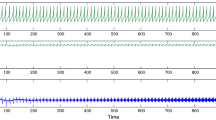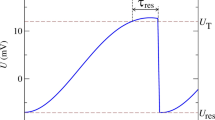Abstract.
We studied the influence of noisy stimulation on the Hodgkin-Huxley neuron model. Rather than examining the noise-related variability of the discharge times of the model – as has been done previously – our study focused on the effect of noise on the stationary distributions of the membrane potential and gating variables of the model. We observed that a gradual increase in the noise intensity did not result in a gradual change of the distributions. Instead, we could identify a critical intermediate noise range in which the shapes of the distributions underwent a drastic qualitative change. Namely, they moved from narrow unimodal Gaussian-like shapes associated with low noise intensities to ones that spread widely at large noise intensities. In particular, for the membrane potential and the sodium activation variable, the distributions changed from unimodal to bimodal. Thus, our investigation revealed a noise-induced transition in the Hodgkin-Huxley model. In order to further characterize this phenomenon, we considered a reduced one-dimensional model of an excitable system, namely the active rotator. For this model, our analysis indicated that the noise-induced transition is associated with a deterministic bifurcation of approximate equations governing the dynamics of the mean and variance of the state variable. Finally, we shed light on the possible functional importance of this noise-induced transition in neuronal coding by determining its effect on the spike timing precision in models of neuronal ensembles.
Similar content being viewed by others
Author information
Authors and Affiliations
Additional information
Received: 19 September 2000 / Accepted in revised form: 4 March 2001
Rights and permissions
About this article
Cite this article
Tanabe, S., Pakdaman, K. Noise-induced transition in excitable neuron models. Biol Cybern 85, 269–280 (2001). https://doi.org/10.1007/s004220100256
Issue Date:
DOI: https://doi.org/10.1007/s004220100256




